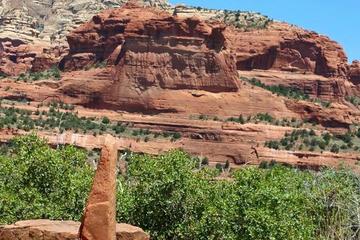
Leavenworth, Washington
by Edward Quan
Want to experience an old fashion German Christmas; yet don’t have the time or resources to fly the family to Europe this December? Consider visiting the Leavenworth Christmas Lighting Festival () located in the heart of the Cascade Mountains of Washington State. Where over half a million Christmas lights with an abundance of holiday cheer sparkles in Washington’s Bavarian Village, some describe it as American’s Ultimate Holiday Town.
Each Friday afternoon on the first three weekends in December, Leavenworth hosts a special holiday lighting ceremony brimming with the sights, sounds and tastes of Christmas. The entire town of only 2000 residents is modeled on a Bavarian village.

During each festival weekend, you can celebrate the arrival of Santa, Mrs. Clause and Father Christmas plus catch live music at the Front Street Gazebo. Christmas carolers and brass bands entertain festival-goers while your little ones can follow the “cookie crawl.” Hail a house-drawn carriage to explore the town while enjoying roasting chestnuts or enjoy the live Nativity scene.
For many Europeans, celebrating Christmas in Germany has become an annual promised weekend getaway. In recent years, Christmas Markets have popped up everywhere, from Nuremberg that host one of Germany’s oldest Christmas markets to small medieval villages all over the countryside. The first Germany Christmas fairs dates back to the 15th century, held during the four weeks of advent. Most are found in German–speaking part of Europe and parts of the former Holy Roman Empire that includes eastern regions of France and Switzerland. Celebrated in the town’s square where villagers would erect and decorate the largest Christmas tree they could find and surrounded it with festive open-air stalls offering hand-made arts and crafts and tasty treats.

Leavenworth Christmas Lighting Festival will take your family back to a traditional Christmas, away from the commercialism that has taken over the holidays. Like Germany, the village shops are filled with gifts from a simpler past, woodcarving and toys, marionettes and my favorite, nutcrackers in all sizes. A must-see is the Nutcracker Museum (www.nutcrackermuseum.com), where you will learn the origin of nutcrackers and how they became intricate and colorful designs.
Culture abounds within the village during the season with plays, harp concerts, choir performances, hand bell ringer’s concerts and musicals. In the surrounding hills, you have snow boarding at Mission Ridge and Stevens Pass. Plus a tube park, sleigh rides and Nordic trails/snowshoeing minutes from town.

The mountain air always works up an appetite, for foodies, grab a spiced mulled wine or cider from the gluhwein tent. From gingerbread and German sausages to fine dining, you will find a world of options in Leavenworth.
For those that can’t make it during Leavenworth Christmas Light Festival Weekends, the holiday lights shine bright all week long from the American Thanksgiving weekend until the end of February.
Discover the magic of an old fashioned Christmas this year in Leavenworth.


If You Go:
♦ By Car – Leavenworth is easily accessible from Seattle WA via US-2 or US-97. Travel time is about 2 hours. Traction tires required during winter months.
♦ By Train – Amtrak services Leavenworth eastbound from Seattle and westbound from Chicago.
♦ By Bus – Trailways offers daily bus service directly from Seattle.
♦ Leavenworth Christmas Lighting Festival Bus Tours – Clipper Vacations offers day trips from Seattle each weekend.
♦ Accomodations – Contact the Leavenworth Chamber of Commerce for hotel availability. Wenatchee is an alternative about 30 miles southeast. Book early.
About the author:
Edward Quan, travel writer has a background in European luxury fashion. He lives and breathes the world of luxury travel. From the style capitals across the globe, Edward Quan covers their influences with designer fashion. May it be art and culture, music and cinema, to history and architecture. Writing exceptional stories on personal style while traveling well, featuring the latest news on luxury hotels and resorts, fine food & wine and of course, shopping.
Photos courtesy of the Leavenworth Chamber of Commerce:
Leavenworth Washington in winter
Horse-drawn carriage
Lights downtown
Leavenworth Chamber


 Andersonville was originally named Camp Sumter. It was built in early 1864, as Confederate officials wanted a larger space to house thousands of federal prisoners from Virginia and Georgia. In its short life, the camp confined 45,000 soldiers. Over 13,000 died from starvation, disease, overcrowding and poor sanitation. Half of all Union prisoner deaths occurred at this horrific site. From February, four hundred Union soldiers arrived every day and by the end of June, 26,000 men occupied a space that was originally designed for 10,000. One of the first stops was the entrance to the North gate. You can walk up the hill and follow the footsteps of where Union soldiers entered the prison for the first time. This was an incredibly powerful experience. One soldier exclaimed on his arrival, “is this hell?” I stood there for a while, trying to imagine the sights and smells those soldiers faced. Of course, nothing I could imagine would come close: people complained about the stench of the prison ten miles away. At its height, 130 prisoners died every single day. It was such a high rate that coffins could not be built fast enough. Instead, bodies were dumped in mass graves. Opposite the North gate, there stands a large empty field, originally the place where the prison hospital stood. Many soldiers refused to go, knowing they would never come out. Now all you can hear is the wind rustling through the tall grass.
Andersonville was originally named Camp Sumter. It was built in early 1864, as Confederate officials wanted a larger space to house thousands of federal prisoners from Virginia and Georgia. In its short life, the camp confined 45,000 soldiers. Over 13,000 died from starvation, disease, overcrowding and poor sanitation. Half of all Union prisoner deaths occurred at this horrific site. From February, four hundred Union soldiers arrived every day and by the end of June, 26,000 men occupied a space that was originally designed for 10,000. One of the first stops was the entrance to the North gate. You can walk up the hill and follow the footsteps of where Union soldiers entered the prison for the first time. This was an incredibly powerful experience. One soldier exclaimed on his arrival, “is this hell?” I stood there for a while, trying to imagine the sights and smells those soldiers faced. Of course, nothing I could imagine would come close: people complained about the stench of the prison ten miles away. At its height, 130 prisoners died every single day. It was such a high rate that coffins could not be built fast enough. Instead, bodies were dumped in mass graves. Opposite the North gate, there stands a large empty field, originally the place where the prison hospital stood. Many soldiers refused to go, knowing they would never come out. Now all you can hear is the wind rustling through the tall grass. As the circular loop goes round, the last stop informs the visitor about sheltering the prisoners. The Confederate army could not supply adequate food or clothing, and soldiers were expected to make their own tents out of any material they could find, a small sheet or ripped trousers which was meant to protect them through rain or shine. Many had no shelter at all. Unsurprisingly, it was a “hell on earth.”
As the circular loop goes round, the last stop informs the visitor about sheltering the prisoners. The Confederate army could not supply adequate food or clothing, and soldiers were expected to make their own tents out of any material they could find, a small sheet or ripped trousers which was meant to protect them through rain or shine. Many had no shelter at all. Unsurprisingly, it was a “hell on earth.”
 A national cemetery was established at Andersonville in the summer of 1865. During the Camp’s operation, prisoner Dorence Atwater was assigned the task of recording the soldiers who died for the Confederate officials, but unbeknownst to them, Atwater kept a second copy for himself. After the War, Atwater wanted to give the Union prisoners a proper burial, and when the federal government spurned him, he enlisted the help of Clara Barton. A heroine of mine, Barton founded the American Red Cross and nursed thousands of men during the War. Atwater and Barton identified over 12,000 soldiers buried at Andersonville. There are over 500 unknown soldiers buried in the cemetery, something I have always thought of as a cruel twist of fate since visiting the First World War battlefields of France. Today, Andersonville is still an active cemetery (active in the sense that soldiers can choose to be buried there) and the roll call presently stands at 18,000.
A national cemetery was established at Andersonville in the summer of 1865. During the Camp’s operation, prisoner Dorence Atwater was assigned the task of recording the soldiers who died for the Confederate officials, but unbeknownst to them, Atwater kept a second copy for himself. After the War, Atwater wanted to give the Union prisoners a proper burial, and when the federal government spurned him, he enlisted the help of Clara Barton. A heroine of mine, Barton founded the American Red Cross and nursed thousands of men during the War. Atwater and Barton identified over 12,000 soldiers buried at Andersonville. There are over 500 unknown soldiers buried in the cemetery, something I have always thought of as a cruel twist of fate since visiting the First World War battlefields of France. Today, Andersonville is still an active cemetery (active in the sense that soldiers can choose to be buried there) and the roll call presently stands at 18,000.
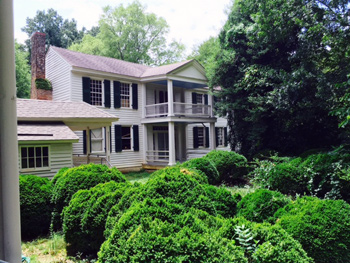
 In these days of distaste for the Confederate flag and all it represents, North Alabama continues to take great pride in preserving Pond Spring, the home of “Fightin’ Joe” Wheeler, the only former Confederate general buried in Arlington Cemetery. In truth, the Confederate flag never flew in front of Pond Spring. General Wheeler was also important in the Spanish-American War, served in the U.S. Congress, and did much to promote reconciliation of the North and South in the late 1800s to early 1900s. Joseph Wheeler was not just a Southern hero, but much more, he was an American hero.
In these days of distaste for the Confederate flag and all it represents, North Alabama continues to take great pride in preserving Pond Spring, the home of “Fightin’ Joe” Wheeler, the only former Confederate general buried in Arlington Cemetery. In truth, the Confederate flag never flew in front of Pond Spring. General Wheeler was also important in the Spanish-American War, served in the U.S. Congress, and did much to promote reconciliation of the North and South in the late 1800s to early 1900s. Joseph Wheeler was not just a Southern hero, but much more, he was an American hero.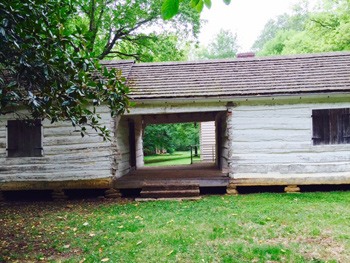 Annie Wheeler, third child of Joseph and Daniella, showed her own patriotic dedication by serving as a Red Cross nurse in three wars She was the last family member to live in the home and was responsible for bequeathing the buildings and all of their contents to the State of Alabama for historical preservation. The 50-acre property has several outbuildings, including a dogtrot log house built around 1818, and an ice house. Delightful stories exist about the railroad track that runs near the entrance to Pond Spring.
Annie Wheeler, third child of Joseph and Daniella, showed her own patriotic dedication by serving as a Red Cross nurse in three wars She was the last family member to live in the home and was responsible for bequeathing the buildings and all of their contents to the State of Alabama for historical preservation. The 50-acre property has several outbuildings, including a dogtrot log house built around 1818, and an ice house. Delightful stories exist about the railroad track that runs near the entrance to Pond Spring.
 The tallest monument, in the family cemetery several yards behind the house, adorns the grave of Daniella Wheeler. An identical obelisk sits atop General Wheeler’s grave at Arlington and is the tallest marker in the entire cemetery, standing an impressive 45 feet. After it was erected, the Arlington Committee quickly enacted a policy specifying future heights and widths of monuments. They were afraid the competition of outdoing others for “bigger and better” would get out of hand. A smart move on their part.
The tallest monument, in the family cemetery several yards behind the house, adorns the grave of Daniella Wheeler. An identical obelisk sits atop General Wheeler’s grave at Arlington and is the tallest marker in the entire cemetery, standing an impressive 45 feet. After it was erected, the Arlington Committee quickly enacted a policy specifying future heights and widths of monuments. They were afraid the competition of outdoing others for “bigger and better” would get out of hand. A smart move on their part.

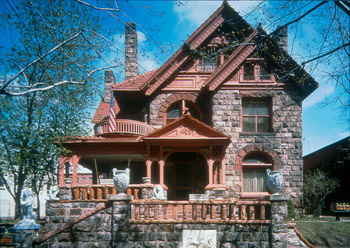 by Connie Pearson
by Connie Pearson 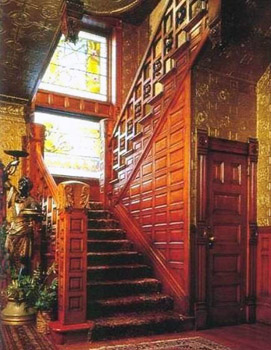 During a recent conference in Denver, my fellow attendees and I were given a 3-hour time period and told to “go out and explore Denver.” I chose to take a taxi from my downtown hotel and visit the Molly Brown House Museum. Dubbed “The House of Lions” because of the imposing lion statues the Browns purchased for the front of the house, it is located at 1340 Pennsylvania Street. Very few of the furnishings and artifacts are original to the time Molly Brown lived there, but careful study of photos made in 1910, have helped Historic Denver, Inc. with their extensive restoration efforts. Visitors have an authentic experience.
During a recent conference in Denver, my fellow attendees and I were given a 3-hour time period and told to “go out and explore Denver.” I chose to take a taxi from my downtown hotel and visit the Molly Brown House Museum. Dubbed “The House of Lions” because of the imposing lion statues the Browns purchased for the front of the house, it is located at 1340 Pennsylvania Street. Very few of the furnishings and artifacts are original to the time Molly Brown lived there, but careful study of photos made in 1910, have helped Historic Denver, Inc. with their extensive restoration efforts. Visitors have an authentic experience.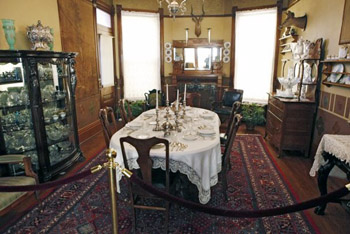 The trivial threads holding us together end at that point. Molly’s life story, as shared by the docent, unfolded as an amazing inspiration and picture of the power of what one determined woman can accomplish.
The trivial threads holding us together end at that point. Molly’s life story, as shared by the docent, unfolded as an amazing inspiration and picture of the power of what one determined woman can accomplish. In 1901, she attempted to win a seat in the state senate, in spite of a popular saying of the day (one that was strongly supported by her husband): “A woman’s name should appear in the newspaper only 3 times: at her birth, when she gets married, and at her death.” The pressure must have been tremendous, because she withdrew from the race before Election Day. It was no surprise to learn that she was active in the women’s suffrage movement.
In 1901, she attempted to win a seat in the state senate, in spite of a popular saying of the day (one that was strongly supported by her husband): “A woman’s name should appear in the newspaper only 3 times: at her birth, when she gets married, and at her death.” The pressure must have been tremendous, because she withdrew from the race before Election Day. It was no surprise to learn that she was active in the women’s suffrage movement.
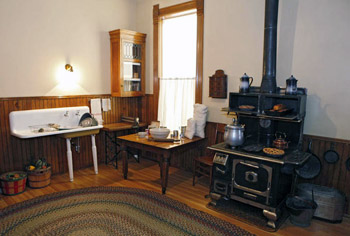 You will see colorful stained glass windows, ornately-carved woodwork, and anaglypta wall coverings. You will learn that this house had indoor plumbing, electricity, central heat and a telephone long before other homes had these conveniences. But, most of all, you will leave wanting to know more about Margaret Tobin Brown and her indomitable – yes, unsinkable – compassion for others and zeal for life.
You will see colorful stained glass windows, ornately-carved woodwork, and anaglypta wall coverings. You will learn that this house had indoor plumbing, electricity, central heat and a telephone long before other homes had these conveniences. But, most of all, you will leave wanting to know more about Margaret Tobin Brown and her indomitable – yes, unsinkable – compassion for others and zeal for life.

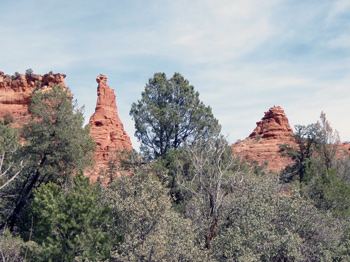
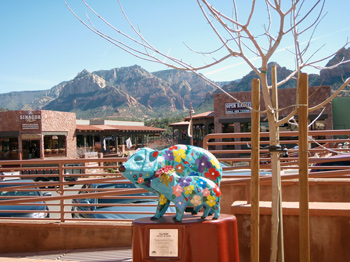 The town provides a relaxed atmosphere with a creative flair. The soothing terracotta buildings blend in perfectly with the surroundings. The town centre displays samples of local paintings, sculptures and carvings. We enjoy the delightful mama javalina (a wild pig-like animal) sculptures in colourful print dresses, with their babies beside them. Wandering the streets of Sedona is like walking through an outdoor art gallery. There are many impressive inside galleries to visit, such as the Sedona Arts Centre. The numerous shops make it difficult not to come away with a special treasure to take home. I can´t resist purchasing a Snoopy Rock T-shirt for my grandson.
The town provides a relaxed atmosphere with a creative flair. The soothing terracotta buildings blend in perfectly with the surroundings. The town centre displays samples of local paintings, sculptures and carvings. We enjoy the delightful mama javalina (a wild pig-like animal) sculptures in colourful print dresses, with their babies beside them. Wandering the streets of Sedona is like walking through an outdoor art gallery. There are many impressive inside galleries to visit, such as the Sedona Arts Centre. The numerous shops make it difficult not to come away with a special treasure to take home. I can´t resist purchasing a Snoopy Rock T-shirt for my grandson.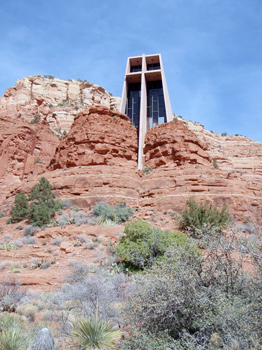 The Church of the Holly Cross built high amongst the bluffs overlooking Sedona is a remarkable work of art. Designed by architect and sculptor Marguerite Brunswig Staude in memory of her parents, it was completed in 1956 and is open to people of all faiths. The view through the picture window, divided in four by an enormous cross, is spectacular. Outside the chapel are perfect photographic opportunities of the area’s stunning rock formations and the valley 200 feet below. An appropriate configuration nearby resembles the Madonna and child and surrounding it are three rock figures that remind you of praying nuns.
The Church of the Holly Cross built high amongst the bluffs overlooking Sedona is a remarkable work of art. Designed by architect and sculptor Marguerite Brunswig Staude in memory of her parents, it was completed in 1956 and is open to people of all faiths. The view through the picture window, divided in four by an enormous cross, is spectacular. Outside the chapel are perfect photographic opportunities of the area’s stunning rock formations and the valley 200 feet below. An appropriate configuration nearby resembles the Madonna and child and surrounding it are three rock figures that remind you of praying nuns.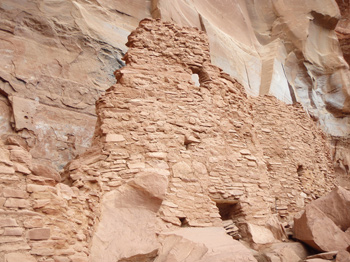 On another day we visit the Palatki Red Cliffs Heritage Site to view pictographs and visit cliff dwellings built by the Sinagua Indians 900 years ago. Walking sticks are provided to get to the sites situated on the steep sides of the cliffs. Due to their location, the well preserved dwellings have not been touched by rain. The masonry blends well with the red sandstone providing security to the dwellers. No one knows what eventually happened to the inhabitants, but the sense of family can be felt as we peer into the rooms where people carried out their day to day activities. The finger prints remain, if not to the human eye. This is not a place to wear white as I soon learn. The iron oxide that makes the sandstone red leaves evidence of your visit. We are also careful to dodge the Costco sized prickly-pear cacti that are everywhere.
On another day we visit the Palatki Red Cliffs Heritage Site to view pictographs and visit cliff dwellings built by the Sinagua Indians 900 years ago. Walking sticks are provided to get to the sites situated on the steep sides of the cliffs. Due to their location, the well preserved dwellings have not been touched by rain. The masonry blends well with the red sandstone providing security to the dwellers. No one knows what eventually happened to the inhabitants, but the sense of family can be felt as we peer into the rooms where people carried out their day to day activities. The finger prints remain, if not to the human eye. This is not a place to wear white as I soon learn. The iron oxide that makes the sandstone red leaves evidence of your visit. We are also careful to dodge the Costco sized prickly-pear cacti that are everywhere.
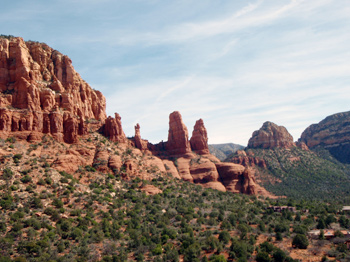 Sedona has a unique blend of history and new ageism. The area is well known for the energy originating from its many vortexes. My daughter finds the vortex sights fascinating. She visits the Boynton Canyon vortex and discovers a positive magnetic energy near a tall majestic rock called Kachina Woman. She comes away feeling energized and contented. There are many vortex tours available, but you can wander the sites yourself as well.
Sedona has a unique blend of history and new ageism. The area is well known for the energy originating from its many vortexes. My daughter finds the vortex sights fascinating. She visits the Boynton Canyon vortex and discovers a positive magnetic energy near a tall majestic rock called Kachina Woman. She comes away feeling energized and contented. There are many vortex tours available, but you can wander the sites yourself as well.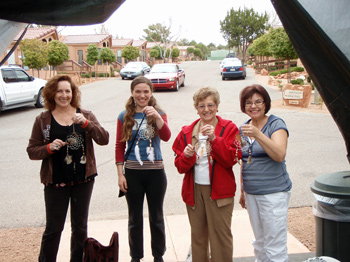 A short drive takes us to Jerome, an old mining town built on a hill. Home to many brothels in its day, these former houses of ill repute now house unique shops displaying artists’ wares, next to clothing and odds and ends. We chat with a nonchalant painter perched by her easel on the sidewalk, painting a gnarled old tree overlooking the russet cliffs.
A short drive takes us to Jerome, an old mining town built on a hill. Home to many brothels in its day, these former houses of ill repute now house unique shops displaying artists’ wares, next to clothing and odds and ends. We chat with a nonchalant painter perched by her easel on the sidewalk, painting a gnarled old tree overlooking the russet cliffs.
